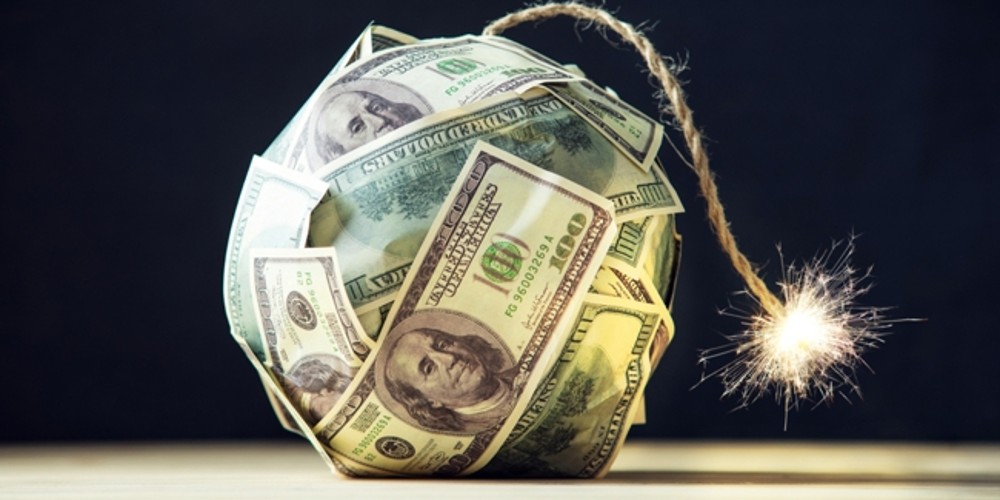(International Man)—The US government can no longer delay or disguise its impending bankruptcy. The US federal government has the biggest debt in the history of the world. And it’s continuing to grow at a rapid, unstoppable pace.
First, let me put some crucial numbers and concepts into perspective. You often hear the media, politicians, and financial analysts casually toss around the word “trillion” without appreciating what it means. A trillion is a massive, almost unfathomable number.
The human brain has trouble understanding something so huge. The image below shows stacks of $100 bills and a human for reference.
Suppose you had a job that paid you $1 per second, or $3,600 per hour. That amounts to $86,400 per day and about $32 million per year. With that job, it would take you 31.5 years to earn a billion dollars. With that job, it would take you over 31,688 YEARS to earn a trillion dollars.
Suppose you earned $75,000 a year, which is the typical household income in the US. It would take you over 13 million years to make a trillion dollars. If you had a trillion one-dollar bills, you could cover the surface area of Delaware twice over. If you stacked a trillion one-dollar bills on top of each other, it would reach 67,866 miles high, about one-fourth of the distance from Earth to the moon. If you took that same trillion one-dollar bills and instead stacked them end-to-end, the length would exceed the distance between the Earth and the sun.
So that’s how enormous a trillion is.
Which crypto-backed IRA is best?
– BlockTrust IRA is ideal for managed accounts.
– iTrustCapital is for buy and hold.
When politicians carelessly spend and print money measured in the trillions, they are in dangerous territory. And that is precisely what the fiat currency system has enabled the US government to do.
Today, the US federal debt has gone parabolic and is over $35 TRILLION. To put that in perspective, if you earned $1 a second 24/7/365—about $31 million per year—it would take over 1,109,080 YEARS to pay off the US federal debt. And that’s with the unrealistic assumption that it would stop growing.
In short, the US government can’t repay its debt. It can’t even pay the interest expense without going into further debt. Default is inevitable.
It Will Not Be an Explicit Default
The US government is out of options and cannot repay what it has borrowed. Therefore, the question is not whether the US government will default but how.
Consider the recurring debt ceiling farce in the US Congress, which has been raised over 100 times since 1944 to avoid an explicit default. When faced with a choice, politicians always choose the most expedient option.
In this case, that means issuing more debt rather than making tough budget decisions or explicitly defaulting. That raises an important question: who will buy all this debt (Treasuries)?
Historically, there has been a vast foreign appetite for Treasuries, but not anymore. In the wake of Russia’s invasion of Ukraine in 2022, the US government has launched its most aggressive sanctions campaign ever.
The US government and its allies froze around $300 billion of the Russian central bank’s reserves—the nation’s accumulated savings.
It was a stunning illustration of the political risk associated with the US dollar and Treasuries. It showed that the US government could deny access to another sovereign country’s reserves at the flip of a switch.
Then, in April 2024, President Joe Biden signed the REPO Act into law. It allows the US government to seize frozen Russian state assets and transfer the funds to Ukraine.
In short, the US dollar and Treasuries have become weaponized in a way they had not before. They are now clearly not neutral assets worthy of forming the bedrock of the international financial system but political tools for Washington to coerce others.
The rising political risk attached to Treasuries has made them even less attractive as a store of value. Many countries are undoubtedly wondering if the US government will seize their savings if they run afoul with Washington in even the most trivial ways.
Don’t just survive — THRIVE! Prepper All-Naturals has freeze-dried steaks for long-term storage. Don’t wait for food shortages to get worse. Stock up today. Use promo code “jdr” at checkout for 35% off!
China is one of the largest holders of US Treasuries, and it indeed took note of what is happening. Since 2022—when the US froze Russian state assets—China has sold about 25% of its Treasuries, an enormous change in such a short period.
Even US allies, like Japan, have cut their Treasury holdings. There are numerous other examples. The bottom line is that it’s clear the world isn’t hungry for US debt right now as supply is exploding.
In the bond market, when demand for a bond falls, the interest rate rises to entice buyers and holders. However, the US government cannot allow interest rates to rise because the skyrocketing interest expense has become an urgent threat to its solvency.
The interest expense on the federal debt is already bigger than defense spending and is set to become the largest item in the US government’s budget in months.
If higher interest rates are off the table and cannot entice more natural buyers, who will buy all this debt? The only entity capable of doing this is the Federal Reserve, which buys Treasuries with dollars it creates out of thin air.
Here’s the bottom line.
The US government can’t pay off its debt. They won’t explicitly default. They can’t entice a meaningful amount of new Treasury buyers by allowing interest rates to rise. That means currency debasement is their only practical option.
Fed Chair Powell’s recent pivot to monetary easing and rate cuts is compounding the situation. That means the Fed has given up on bringing inflation down… even though it remains well above their target. It’s an incredible failure and will have ENORMOUS investment implications for the US dollar and gold.
If the gold price is already hitting record highs, imagine what will happen when the Fed flips back to easing with even more currency debasement than the previous rounds of stimulus.
I think the gold price could skyrocket. The last time the US experienced runaway inflation was in the 1970s. Then, gold skyrocketed from $35 per ounce to $850 in 1980—a gain of over 2,300% or more than 24x.
I expect the percentage rise in the price of gold to be at least as significant as it was during the 1970s. While this megatrend is already well underway, I believe the most significant gains are still ahead.




